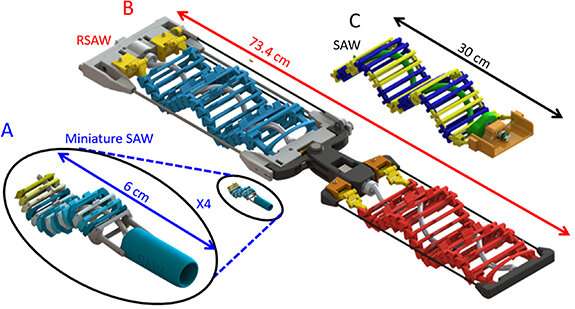Crawling SAW robots previously designed by our group based on the same single motor wave mechanism. (A) A miniature version of SAW measuring 6 cm in length. (B) RSAW, a reconfigurable version with two wave mechanisms attached, using an actuated U joint. (C) The original 30 cm long SAW robot. Credit: Bioinspiration & Biomimetics (2023). DOI: 10.1088/1748-3190/acb1e8
Ben-Gurion University of the Negev engineer Dr. David Zarrouk and his student Omer Guetta have developed AmphiSAW, one of the fastest and most efficient amphibious robots. Befitting the director and member of the Bioinspired and Medical Robotics Lab, the robot's movement in water is inspired by the movement of flippers and its land movements are inspired by centipedes.
Their findings were published earlier this month in Bioinspiration & Biomimetics.
The robot has potential applications in search and rescue, especially during natural disasters such as floods and tsunamis. It also has potential applications in marine agriculture and fish feeding as the robot attracts fish instead of repelling them.
Credit: Ben-Gurion University of the Negev
Whether on land or in the water, the robot moves quite quickly. On land, the robot crawled at 1.5 body lengths per second (B/s) and swam at 0.74 B/s. It can be outfitted with legs or wheels at the front which increases its crawl speed, especially over uneven terrain.
"The single motor and bioinspired design contribute significantly to the robot's efficiency and the relative simplicity of its design means it is scalable to any size," explains Dr. Zarrouk.
His research goal is to produce robots that can complete complex maneuvers yet use very little power to run and are straightforward to produce.
More information: Omer Guetta et al, A novel wave-like crawling robot has excellent swimming capabilities, Bioinspiration & Biomimetics (2023). DOI: 10.1088/1748-3190/acb1e8
Journal information: Bioinspiration and Biomimetics
Provided by Ben-Gurion University of the Negev























